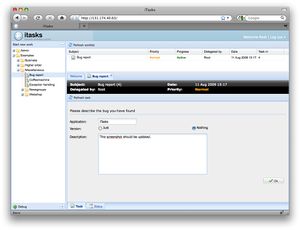Difference between revisions of "ITasks"
Bas Lijnse (talk | contribs) |
Bas Lijnse (talk | contribs) |
||
| Line 19: | Line 19: | ||
The iTask system is actively developed, but not regularly released. You can get the development trunk from our subversion repository. | The iTask system is actively developed, but not regularly released. You can get the development trunk from our subversion repository. | ||
You can get started with iTasks by following the following three steps: | You can get started with iTasks by following the following three steps: | ||
| − | # Install a Clean 2.3 system | + | # Install a [[Clean 2.3]] system for 32-bit Windows. |
# Check out the iTask trunk https://svn.cs.ru.nl/repos/iTask-system/trunk to a directory named 'iTasks-SDK' in your Clean 2.3 directory. | # Check out the iTask trunk https://svn.cs.ru.nl/repos/iTask-system/trunk to a directory named 'iTasks-SDK' in your Clean 2.3 directory. | ||
# Follow the setup instructions in README.txt | # Follow the setup instructions in README.txt | ||
Revision as of 12:58, 14 July 2011
The iTask system (iTasks) is a task-oriented programming toolkit for programming workflow support applications in Clean.
With this toolkit workflows can be speficied using combinators in a very high level declarative monadic style. Workflows consist of typed tasks that produce results that can be passed as parameters to other tasks. Tasks are constructed by combining single steps sequentially or in parallel. From iTask specifications, executable workflow support systems are generated automatically.
This latest version features:
- A highly declarative API for specification of dynamic workflows
- A rich Ajax client interface for working on tasks
- Automatically generated editors for entering and updating data in workflows.
- A JSON based service API for spawning and interacting with running workflow instances
- The possibility to change running workflow instances
Get from subversion
The iTask system is actively developed, but not regularly released. You can get the development trunk from our subversion repository. You can get started with iTasks by following the following three steps:
- Install a Clean 2.3 system for 32-bit Windows.
- Check out the iTask trunk https://svn.cs.ru.nl/repos/iTask-system/trunk to a directory named 'iTasks-SDK' in your Clean 2.3 directory.
- Follow the setup instructions in README.txt
Download release
We provide alpha builds on request or on special occasions such as use during courses. If you want to see the latest iTasks developments it is better to check out from subversion.
The latest development release is version 10.8 (Aug. 2010) which you can download below.
For this release you need a preview version of Clean 2.3 with a modified compiler which you can download from the Clean download page or directly using the link below:
To get started you need both the latest Clean release for iTasks and the latest release of the iTasks-SDK, which can be downloaded from this page. To combine them follow these steps:
- Unzip the Clean system into any directory on your system.
- Unzip the iTasks-SDK-XX.zip into the root-folder of the Clean System. This will create a folder 'iTasks-SDK'. It is required to put the iTasks system in this directory for the 'iTasks'-environment to work.
- Follow the instructions in 'readme.txt'. A build of the AJAX web-client is already included in the release, so you don't have to create one for yourself.
Documentation
Documentation of iTasks is still mostly done in scientific papers (look for iTasks on the Publications page). On this Wiki the following additional resources are available:
Browsers
The iTask system works with most browsers. IE 9 is a known exception, we are working on that.
Using the iTask system with Firefox can be very slow. This is caused by a delay that is added by Firefox for all events for localhost. There are several solutions and workarounds:
- Find out what your current ip address and use that instead of http://localhost/.
- Better: use http://127.0.0.1/ instead of http://localhost/.
- best: change the settings of Firefox.
- type as url: about:config
- search for v6, you will see network.dns.disableIPv6
- toggle the value of this parameter to True.

